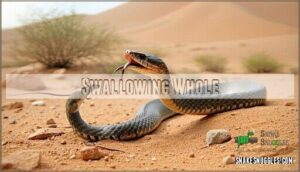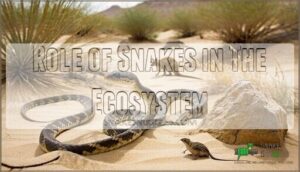This site is supported by our readers. We may earn a commission, at no cost to you, if you purchase through links.

Desert snakes are nature’s ultimate opportunists, adapting their diet to whatever’s available in their harsh environment.
They’ll hunt mice, rats, ground squirrels, small birds, and even other snakes when the opportunity arises.
Some species prefer insects and larvae, while larger snakes can tackle rabbits.
These resourceful predators use venom, constriction, or swift strikes to capture prey, then swallow it whole.
Their slow metabolism allows them to survive weeks or months between meals.
Each species has evolved specific hunting techniques that make them surprisingly effective desert survivors, using their unique abilities to thrive in the desert environment with slow metabolism.
Table Of Contents
- Key Takeaways
- What Do Snakes Eat in The Desert?
- Insect and Small Prey Diet
- Hunting Techniques
- Role of Snakes in The Ecosystem
- Predators and Threats
- Attracting Snakes With Prey
- Unique Diets in The Desert
- Managing The Rodent Population
- Frequently Asked Questions (FAQs)
- How do snakes survive in the desert?
- What food does a snake eat?
- What eats a king snake in the desert?
- What foods attract snakes?
- Do desert snakes scavenge dead animals?
- How do desert snakes locate frog prey?
- Which bird species are targeted by desert snakes?
- Are there rodents that desert snakes avoid?
- How often do desert snakes feed?
- Do desert snakes eat other snakes regularly?
- Conclusion
Key Takeaways
- You’ll find desert snakes are opportunistic hunters that eat rodents, birds, lizards, insects, and eggs, adapting their diet to whatever’s available in harsh desert conditions.
- You can observe three main hunting techniques: ambush tactics where they wait motionlessly for prey, venom injection to paralyze victims, and constriction to suffocate larger animals before swallowing them whole.
- You’re looking at nature’s pest controllers – desert snakes consume 1-3 rodents per week and control 70% of desert rodent populations, preventing agricultural damage and maintaining ecological balance.
- You’ll discover these reptiles can survive weeks or months between meals due to their slow metabolism, making them perfectly adapted to the unpredictable food availability in desert environments.
What Do Snakes Eat in The Desert?
Throughout the harsh desert landscape, desert snakes have mastered survival by adapting their diet to whatever prey they can find.
You’ll discover that rodents form the backbone of most desert snake diets, with mice and rats offering essential protein in these unforgiving environments.
Lizards rank as equally important prey, from tiny geckos to larger desert iguanas that bask on sun-warmed rocks.
Birds become targets during migration seasons, while insects provide quick energy when larger meals are scarce.
Prey availability fluctuates dramatically with seasons and rainfall, forcing snakes to develop remarkable dietary adaptations.
Some species practice snake cannibalism when food becomes extremely limited, targeting smaller snakes to survive.
Water sources attract both predators and prey, creating hunting hotspots where snakes ambush thirsty animals.
Venom potency varies among species, with some delivering powerful toxins to immobilize swift desert prey efficiently.
The desert environment is characterized by harsh desert landscape and unforgiving environments, making survival a significant challenge for desert snakes.
These snakes have adapted to their environment in various ways, including developing strategies to hunt and survive in areas with limited food and water.
Insect and Small Prey Diet
When exploring what desert snakes actually consume, you’ll discover their remarkable appetite for desert insects and small prey.
Desert snakes devour everything from tiny beetles to hefty rodents, proving nature’s ultimate survivors never skip a meal.
These adaptable predators don’t limit themselves to larger meals—they actively hunt desert arthropods including beetles, grasshoppers, crickets, and arachnids.
Snakelet diets particularly rely on this insect nutrition, as younger snakes target smaller prey that matches their size.
Dietary adaptations allow desert insectivores to capitalize on seasonal prey availability, supplementing their nutrition when larger animals become scarce.
This diverse feeding strategy helps snakes survive harsh desert conditions where every meal counts for survival.
Their thick scales minimize water loss in arid environments.
Hunting Techniques
You’ll find that desert snakes have evolved remarkable hunting methods to capture prey in one of Earth’s harshest environments.
These reptiles combine stealth, specialized anatomy, and precise timing to secure meals that keep them alive in extreme conditions.
Ambushing
In desert environments, you’ll witness snakes mastering Patient Waiting as their primary hunting strategy.
These predators rely on Camouflage Tactics and Sensory Input to detect approaching prey, then release lightning-fast Strike Speed when opportunities arise.
Snakes also use their Jacobson’s organ to enhance olfactory prey detection.
- Motionless positioning beneath rocks or sand
- Heat-sensing detection of warm-blooded targets
- Lightning-quick strikes lasting mere milliseconds
- Perfect timing synchronized with prey movement
Venom Immobilization
When ambushing isn’t enough, venomous desert snakes deploy a chemical arsenal.
You’ll find venom delivery systems perfectly engineered for swift prey immobilization.
Snake hunting becomes lethal precision as toxins flood the victim’s bloodstream, disrupting essential functions within seconds.
| Venom Aspect | Desert Snake Application |
|---|---|
| Venom Composition | Neurotoxins and hemotoxins target organs |
| Venom Delivery | Hollow fangs inject precise doses |
| Bite Effects | Paralysis and tissue breakdown occur |
| Prey Digestion | Enzymes begin breaking down tissues |
| Snake Resistance | Some desert prey show natural immunity |
These hunting techniques showcase incredible predator-prey relationships evolution.
Some enthusiasts even collect and study snake fang replicas.
Constriction
When a constrictor strikes, it wraps its powerful body around prey like a living rope.
Constriction strength creates crushing pressure that causes ribcage collapse, leading to prey suffocation.
This hunting technique offers evolutionary advantages since size matters – larger constrictors can tackle bigger meals.
These hunting strategies prove incredibly effective against various snake prey without requiring venom.
Some products enhance snake’s constriction ability.
Swallowing Whole
Once you’ve captured prey through constriction, jaw flexibility becomes your secret weapon.
Your esophagus expansion allows you to consume prey twice your head’s width. Swallowing mechanics involve unhinging jawbones and using backward-pointing teeth to guide victims down.
For specialized tools, consider snake flexibility products.
Bone digestion happens through powerful stomach acids, while prey size determines digestion time for your desert snake diet.
Role of Snakes in The Ecosystem
You mightn’t realize it, but those slithering hunters you’ve just learned about serve as nature’s quality control managers in the desert ecosystem.
These serpentine regulators maintain ecosystem balance by preventing any single prey species from taking over their harsh environment.
Desert snakes act as essential links in the desert food chain, creating intricate predator-prey relationships that keep everything running smoothly.
Here’s how they shape their world:
- Control rodent populations that could otherwise devastate desert vegetation
- Serve as indicator species, showing scientists how healthy the desert ecosystem remains
- Support biodiversity impact by creating opportunities for other species to thrive
- Function as both predator and prey, feeding hawks, foxes, and other desert wildlife
- Regulate insect populations during seasonal abundance periods
Without these scaled population control experts, desert ecosystems would quickly spiral into chaos, proving that every creature has its purpose.
Predators and Threats
While desert snakes expertly regulate prey populations, they’re not at the top of the food chain.
Even nature’s most skilled hunters must constantly watch their backs in the unforgiving desert.
These resilient predators face their own survival challenges in harsh desert ecosystems.
Snake predators pose constant threats to desert species:
- Birds of prey swoop down with razor-sharp talons, snatching unsuspecting snakes
- Coyotes and foxes use cunning tactics to outmaneuver even venomous species
- Wild boars ruthlessly dig out burrowing snakes from their hideouts
- Raccoons raid nests, devouring vulnerable eggs and young snakes
- Human impact destroys critical habitat through urban sprawl and agriculture
Habitat loss from climate change forces desert snakes into smaller territories, increasing competition.
Conservation efforts now focus on protecting these essential ecosystem regulators before rodent populations explode unchecked.
Attracting Snakes With Prey
Creating an inviting environment for desert snakes revolves around prey availability and strategic habitat manipulation.
You’ll need to establish water sources and artificial shelters like rock piles to attract rodents, lizards, and birds – essential snake prey.
Desert snakes follow scent lures from abundant small mammals and insects.
Snakes are strict carnivores, and their diet is diverse depending on the species.
| Attraction Method | Target Prey | Implementation |
|---|---|---|
| Rock piles | Lizards, rodents | Stack stones naturally |
| Water features | Birds, amphibians | Shallow dishes work |
| Native vegetation | Insects, small mammals | Plant desert-adapted species |
| Brush shelters | Various prey | Create loose debris piles |
This balanced approach supports natural ecosystems.
Unique Diets in The Desert
Beyond the typical rodent menu, you’ll discover that desert snakes have evolved some truly remarkable dietary adaptations.
These serpents showcase incredible flexibility when prey availability fluctuates throughout harsh seasons. Some species have developed specialized hunting techniques that maximize their success in water-scarce environments.
Desert snakes demonstrate extraordinary dietary diversity through several unique feeding strategies:
- Cannibalistic behavior – Larger species prey on smaller snakes when traditional food sources become scarce
- Egg specialization – Certain species target bird and reptile nests, consuming entire clutches during breeding seasons
- Amphibian hunting – Some desert snakes capitalize on seasonal variation by hunting frogs and toads near temporary water sources
- Insect supplementation – Smaller species rely heavily on insects and arthropods when larger prey remains elusive
These dietary adaptations reflect millions of years of evolution, allowing desert snakes to thrive where other predators struggle to survive. They also require essential trace minerals for balanced nutrition.
Managing The Rodent Population
Snakes eat rodents at remarkable rates, consuming 1-3 per week and controlling 70% of desert rodent populations through systematic hunting.
You’ll find these natural pest controllers working around the clock, preventing exponential rodent growth that could devastate ecosystems.
Snake population impact extends beyond simple predation – they’re breaking breeding cycles and maintaining ecological balance in ways that benefit everyone.
Their rodent control methods save agricultural crops from destruction while reducing disease vector control concerns.
When rodent numbers explode, you’re looking at overgrazing, vegetation loss, and potential health risks.
Desert snake habitat management becomes your ally here, as these hunters use thermal sensing and ambush tactics to target problem areas efficiently.
Snake hunting desert environments keeps nature’s books balanced, protecting both wild spaces and human interests through precise, ongoing population management that no artificial method can match.
Frequently Asked Questions (FAQs)
How do snakes survive in the desert?
You’ll find desert snakes master survival through amazing adaptations.
They slow their metabolism, hunt nocturnally to avoid heat, use specialized organs to detect prey, and can survive months without food by conserving energy efficiently, which showcases their ability to master survival through amazing adaptations.
What food does a snake eat?
Like skilled hunters with endless appetites, you’ll discover snakes are strict carnivores eating rodents, lizards, birds, frogs, and insects.
They can’t digest plants, so their entire diet consists of other animals they capture and swallow whole, making them strict predators.
What eats a king snake in the desert?
In desert environments, you’ll find that king snakes face predation from birds of prey like hawks and eagles, coyotes, foxes, and larger snakes.
They’re also vulnerable to domestic cats and dogs.
What foods attract snakes?
Ironically, you’re probably attracting them without knowing it.
Rodents, bird eggs, pet food left outside, and water sources draw snakes closer.
They follow their dinner—eliminate mice and rats, and you’ll discourage unwanted serpent visitors.
Do desert snakes scavenge dead animals?
Yes, you’ll find desert snakes occasionally scavenging dead animals when live prey becomes scarce.
They’re opportunistic feeders who won’t pass up an easy meal, especially during harsh conditions when hunting requires too much energy, and are occasionally seen doing so.
How do desert snakes locate frog prey?
You’ll find desert snakes using their keen sense of smell and Jacobson’s organ to detect chemical signals from frogs.
They’ll also hunt near water sources during wetter periods when amphibians are most active.
Which bird species are targeted by desert snakes?
Birds of a feather flock together, but desert snakes don’t discriminate.
They target small songbirds, quail, doves, and ground-dwelling species like roadrunners.
They ambush near water sources and nesting areas.
Are there rodents that desert snakes avoid?
Desert snakes generally don’t avoid specific rodent species, but they’ll skip heavily defended or toxic prey.
You’ll find they prefer easier targets over porcupines, skunks, or sick animals that might pose risks.
How often do desert snakes feed?
You’ll find that feeding frequency varies dramatically among desert snake species.
Some eat weekly during active seasons, while others can survive months between meals by slowing their metabolism during harsh conditions, which is a dramatic variation in feeding habits.
Do desert snakes eat other snakes regularly?
Cannibalism happens occasionally among desert snakes, but it’s not their regular dining habit.
You’ll see this behavior more during food shortages or territorial disputes, when larger snakes target smaller ones for survival.
Conclusion
Surprisingly, understanding what snakes eat in the desert reveals nature’s remarkable adaptability in action.
You’ve discovered how these resourceful predators capitalize on every available opportunity, from tiny insects to substantial rabbits.
Their specialized hunting techniques—whether through venom, constriction, or lightning-fast strikes—demonstrate millions of years of evolutionary refinement.
By recognizing these dietary patterns, you’ll better appreciate how desert snakes maintain ecological balance while thriving in one of Earth’s most challenging environments through their incredible survival strategies and ecological balance.















